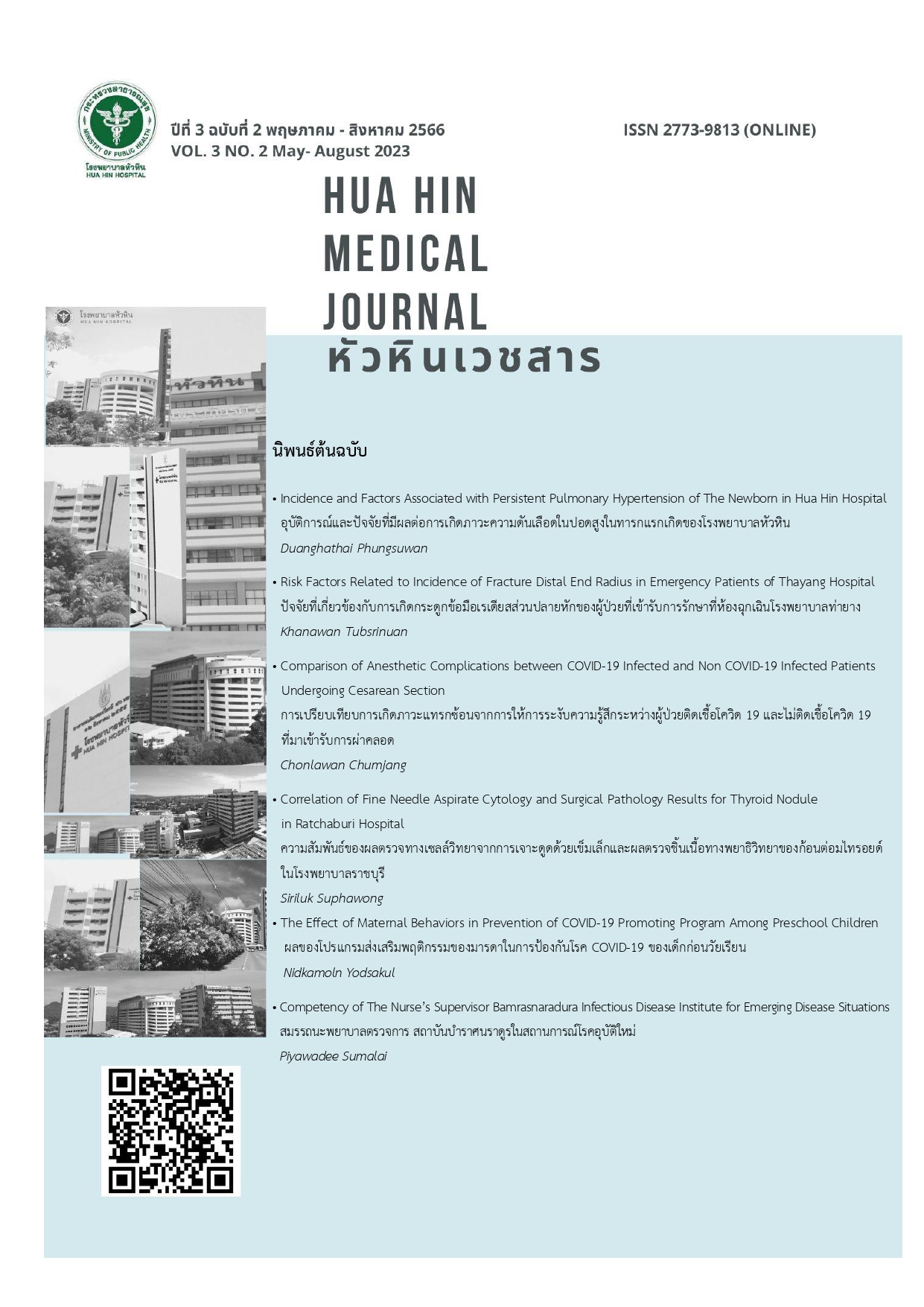Comparison of Anesthetic Complications between COVID-19 Infected and Non COVID-19 Infected Patients Undergoing Cesarean Section
Keywords:
Anesthetic complication, Cesarean section, Pregnancy, COVID-19Abstract
Background: Coronavirus disease 2019 (COVID-19) is a disease that can cause pneumonia and respiratory failure. Pregnancies increase susceptibility to respiratory complications and deaths.
Objectives: This study aims to compare anesthetic complications between COVID-19 infected and non COVID-19 infected patients undergoing cesarean section.
Methods: This study is analyzed as retrospective cohort study which collected data in Samutsakhon Hospital. Patient demographics and information were collected from medical records from July 2021 to June 2022 which involving 146 COVID-19 infected patients and 144 non COVID-19 infected patients.
Results: COVID-19 infected patients were conducted with general anesthesia higher than non COVID-19 infected patients (p=0.026). Incidence of hypotension in patients who conducted with spinal anesthesia was lower in COVID-19 group (p=0.032) and doses of ephedrine were lower in COVID-19 infected group (p=0.01). There were no statistical significant differences in incidences of bradycardia and shivering.
Conclusions: The choice of anesthesia in pregnant women undergoing cesarean section depends on many factors. Complications of general anesthesia are the risk from airway manipulation and viral spread. Complications of spinal anesthesia are hypotension, bradycardia and shivering. This study reveals that incidence of hypotension is lower in COVID -19 infected group. Spinal anesthesia is considered a safe anesthetic technique in COVID-19 parturients.
References
Gorbalenya AE, Baker SC, Baric RS, de Groot RJ, Drosten C, Gulyaeva AA, et al. Severe acute respiratory syndrome-related coronavirus: The species and its viruses – a statement of the Coronavirus Study Group [Internet]. bioRxiv. 2020. Available from: https://www.biorxiv.org/content/10.1101/2020.02.07.937862v1.full.pdf
Zhou F, Yu T, Du R, Fan G, Liu Y, Liu Z, et al. Clinical course and risk factors for mortality of adult inpatients with COVID-19 in Wuhan, China: a retrospective cohort study. Lancet [Internet]. 2020 [cited 2023 Jul 22];395(10229):1054–62. Available from: https://pubmed.ncbi.nlm.nih.gov/32171076/
COVID live - Coronavirus statistics - worldometer [Internet]. Worldometers.info. [cited 2023 Jan 6]. Available from: https://www.worldometers.info/coronavirus/
Moph.go.th. [cited 2023 Jul 22]. Available from: https://hp.anamai.moph.go.th/th/maternal-mortality-ratio/download?id=91778&mid=30954&mkey=m_document&lang=th&did=28085
Zambrano LD, Ellington S, Strid P, Galang RR, Oduyebo T, Tong VT, et al. Update: Characteristics of symptomatic women of reproductive age with laboratory-confirmed SARS-CoV-2 infection by pregnancy status - United States, January 22-October 3, 2020. MMWR Morb Mortal Wkly Rep [Internet]. 2020 [cited 2023 Jan 6];69(25):769–75. Available from: https://pubmed.ncbi.nlm.nih.gov/32584795/
Chen R, Zhang Y, Huang L, Cheng B-H, Xia Z-Y, Meng Q-T. Safety and efficacy of different anesthetic regimens for parturients with COVID-19 undergoing Cesarean delivery: a case series of 17 patients. Can J Anaesth [Internet]. 2020;67(6):655–63. Available from: https://pubmed.ncbi.nlm.nih.gov/32180175/
Fell DB, Dimanlig-Cruz S, Regan AK, Håberg SE, Gravel CA, Oakley L, et al. Risk of preterm birth, small for gestational age at birth, and stillbirth after covid-19 vaccination during pregnancy: population based retrospective cohort study. BMJ [Internet]. 2022 [cited 2022 Nov 28];378:e071416. Available from: https://pubmed.ncbi.nlm.nih.gov/35977737/
Munshi L, Wright JK, Zipursky J, Jorgensen S, Bogler T, Miller KJ, et al. The incidence, severity, and management of COVID-19 in critically ill pregnant individuals. Ontario COVID-19 Science Advisory Table; 2021.
Ababneh O, Alrabayah M, El-Share’ AI, Bsisu I, Bahar Y, Dabousi B, et al. Perioperative outcomes in COVID-19 obstetric patients undergoing spinal anesthesia for cesarean section: A prospective observational study. Healthcare (Basel) [Internet]. 2021 [cited 2022 Nov 28];10(1):23. Available from: https://pubmed.ncbi.nlm.nih.gov/35052187/
Karasu D, Kilicarslan N, Ozgunay SE, Gurbuz H. Our anesthesia experiences in COVID-19 positive patients delivering by cesarean section: A retrospective single-center cohort study. J Obstet Gynaecol Res [Internet]. 2021 [cited 2022 Nov 28];47(8):2659–65. Available from: https://pubmed.ncbi.nlm.nih.gov/33987925/
Aydin Güzey N, Uyar Türkyilmaz E. Evaluation of 254 cesarean sections with COVID-19 in terms of anesthesia and clinical course: 1-year experience. J Anesth [Internet]. 2022 [cited 2022 Nov 28];36(4):514–23. Available from: https://pubmed.ncbi.nlm.nih.gov/ 35691987/
Breslin N, Baptiste C, Gyamfi-Bannerman C, Miller R, Martinez R, Bernstein K, et al. Coronavirus disease 2019 infection among asymptomatic and symptomatic pregnant women: two weeks of confirmed presentations to an affiliated pair of New York City hospitals. Am J Obstet Gynecol MFM [Internet]. Available from: https://pubmed.ncbi.nlm.nih.gov/32292903/
La Scola B, Le Bideau M, Andreani J, Hoang VT, Grimaldier C, Colson P, et al. Viral RNA load as determined by cell culture as a management tool for discharge of SARS-CoV-2 patients from infectious disease wards. Eur J Clin Microbiol Infect Dis [Internet]. 2020 [cited 2022 Nov 28];39(6):1059–61. Available from: https://pubmed.ncbi.nlm.nih.gov/32342252/
Bhatia K, Columb M, Bewlay A, Eccles J, Hulgur M, Jayan N, et al. The effect of COVID-19 on general anaesthesia rates for caesarean section. A cross-sectional analysis of six hospitals in the north-west of England. Anaesthesia [Internet]. 2021 [cited 2022 Nov 28];76(3):312–9. Available from: https://pubmed.ncbi.nlm.nih.gov/33073371/
Sakkawong S, Kullatam P, Kumsang W, Chunate Y. Guidelines for the prevention of COVID-19 transmission from using medical tools and equipment in patient care. SMB [Internet]. 2021 [cited 2022 Nov 28];14(1):41–9.
Sivevski A, Ivanov E, Karadjova D, Slaninka-Miceska M, Kikerkov I. Spinal-induced hypotension in preeclamptic and healthy parturients undergoing cesarean Section. Open Access Maced J Med Sci [Internet]. 2019 [cited 2022 Nov 28];7(6):996–1000. Available from: https://pubmed.ncbi.nlm.nih.gov/30976348/
Aya AGM, Mangin R, Vialles N, Ferrer J-M, Robert C, Ripart J, et al. Patients with severe preeclampsia experience less hypotension during spinal anesthesia for elective cesarean delivery than healthy parturients: a prospective cohort comparison. Anesth Analg [Internet]. 2003 [cited 2022 Nov 28];97(3):867–72. Available from: https://pubmed.ncbi.nlm.nih.gov/12933418/
Flood P, Rollins MD. Anesthesia for obstetrics. Miller’s anesthesia. 2015;8.
Clark VA, Sharwood-Smith GH, Stewart AVG. Ephedrine requirements are reduced during spinal anaesthesia for caesarean section in preeclampsia. Int J Obstet Anesth [Internet]. 2005 [cited 2022 Nov 28];14(1):9–13. Available from: https://pubmed.ncbi.nlm.nih.gov/15627532/
Downloads
Published
How to Cite
Issue
Section
License
Copyright (c) 2023 Hua-Hin Hospital

This work is licensed under a Creative Commons Attribution-NonCommercial-NoDerivatives 4.0 International License.
บทความที่ได้รับการตีพิมพ์ในวารสารหัวหินเวชสาร เป็นลิขสิทธิ์ของโรงพยาบาลหัวหิน
บทความที่ลงพิมพ์ใน วารสารหัวหินเวชสาร ถือว่าเป็นความเห็นส่วนตัวของผู้เขียนคณะบรรณาธิการไม่จำเป็นต้องเห็นด้วย ผู้เขียนต้องรับผิดชอบต่อบทความของตนเอง







